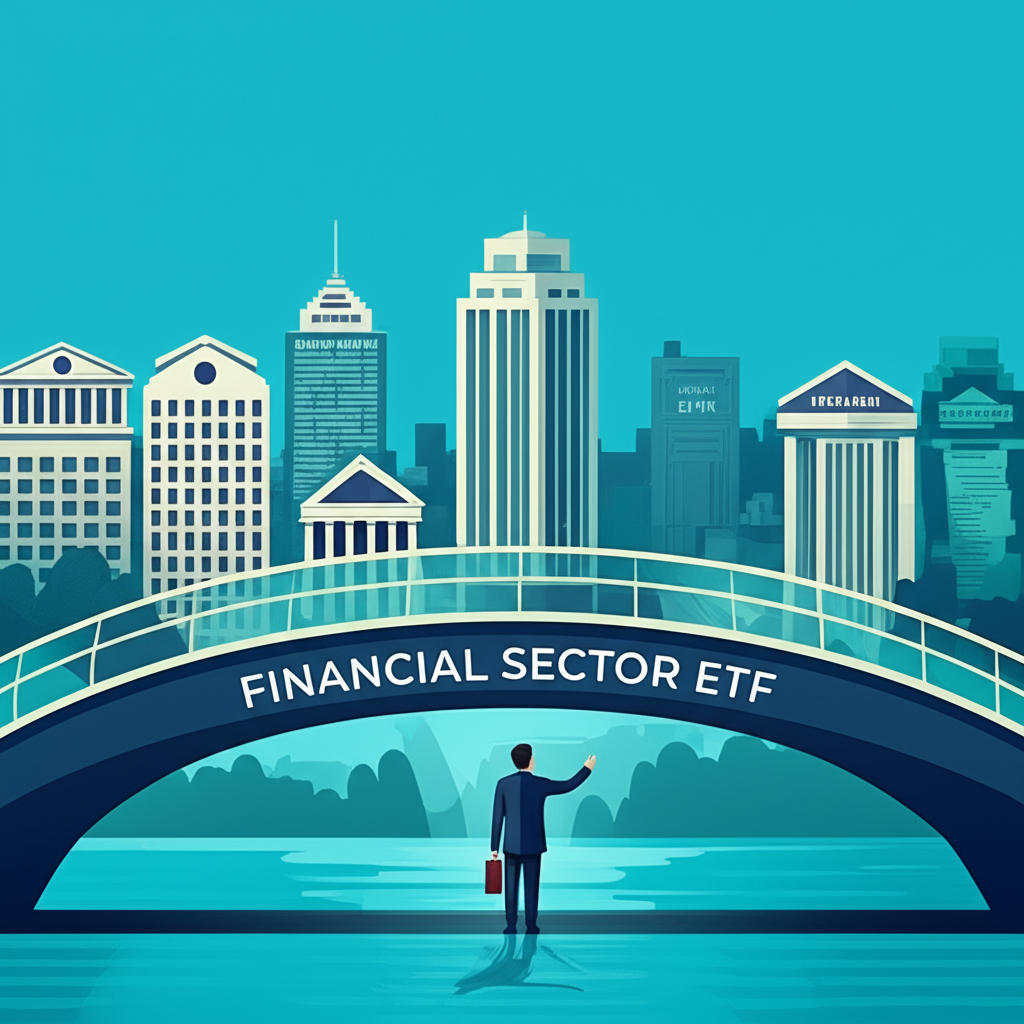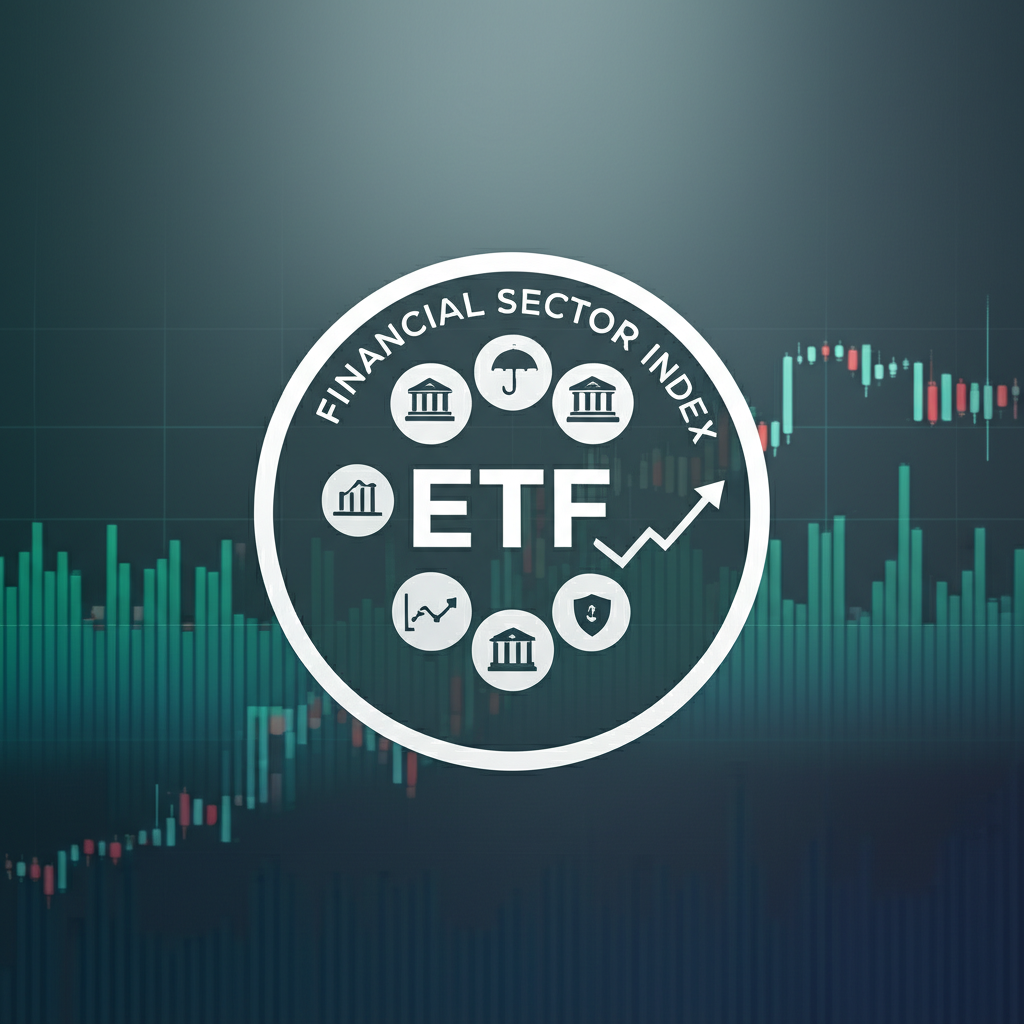Introduction: Understanding Financial Sector ETFs

The financial sector serves as the engine of modern economies, powering everything from daily transactions to global capital markets. For investors aiming to tap into this dynamic industry, financial sector exchange traded funds (ETFs) offer a streamlined and strategic way to gain exposure. Rather than betting on individual stocks, these funds bundle a wide range of financial institutions—banks, insurers, asset managers, fintech innovators, and more—into a single, tradable instrument. As economic tides shift and technological disruption accelerates, financial sector ETFs have emerged as essential tools for both broad market participation and targeted allocation. This guide unpacks how these funds work, their strategic advantages, and the key considerations for incorporating them into a well-rounded portfolio. Whether you’re evaluating long-term growth or hedging against macroeconomic shifts, understanding financial ETFs is a crucial step toward smarter investing.
What Are Financial Sector ETFs?

Financial sector ETFs are investment vehicles that track an index composed of companies operating in financial services. Instead of handpicking individual stocks, investors can use these funds to gain broad exposure to the sector with a single transaction. Designed to mirror the performance of benchmarks like the S&P 500 Financials Index, they provide a cost-effective and liquid way to participate in the financial industry’s ups and downs.
Definition and Core Concept
An exchange traded fund (ETF) is a pooled investment that holds assets such as stocks, bonds, or commodities and trades on exchanges like a stock. A financial sector ETF narrows that focus by investing solely in companies classified within the financial industry. These funds aim to replicate the returns of a financial index, offering investors a diversified stake in banks, insurers, investment firms, and other financial institutions. By owning a share in such an ETF, you’re not relying on the fortunes of one bank or insurer but gaining exposure to the collective performance of the entire sector. This approach simplifies access, reduces single-stock risk, and aligns with a disciplined, market-driven investment strategy.
The Broad Scope of the Financial Sector
The financial sector is far more than just banks—it’s a vast ecosystem of interconnected services that keep money moving and economies functioning. A financial sector ETF often reflects this complexity, drawing from multiple sub-industries:
- Banks: From commercial lenders that serve individuals and businesses to investment banks facilitating mergers and IPOs, and regional banks deeply embedded in local markets. Their profitability hinges on interest rate spreads, loan volume, and economic health.
- Insurance: Encompassing life insurers managing longevity risk and property & casualty firms covering disasters and accidents. These companies thrive on premium income and the returns from investing those premiums, making them sensitive to interest rates and capital markets.
- Capital Markets: Includes brokerage firms, investment banks, and asset managers that underwrite securities, manage portfolios, and advise on corporate finance. Their revenue is tied to market activity, investor sentiment, and asset flows.
- Real Estate (REITs): Though sometimes categorized separately, Real Estate Investment Trusts are often included in financial ETFs due to their reliance on financing, leverage, and capital markets for growth and operations.
- Fintech and Digital Transformation: A fast-growing frontier featuring digital payment platforms, blockchain-based solutions, AI-driven lending, and robo-advisors. These firms are redefining how financial services are delivered, often challenging legacy institutions.
- Asset Management and Custody Banks: Firms that oversee investment portfolios and safeguard client assets, generating fees based on assets under management and trust services.
This diversity means a single financial sector ETF can offer exposure to both traditional profit engines and emerging innovation, depending on its underlying index.
Why Invest in Financial Sector ETFs?

Choosing financial sector ETFs isn’t just about convenience—it’s a strategic decision rooted in macroeconomic insight, diversification, and efficiency. These funds offer a direct line to one of the most influential sectors in any economy, especially when interest rates and credit cycles are shifting.
Diversification Within a Sector
One of the strongest arguments for financial sector ETFs is the instant diversification they deliver. Instead of risking capital on a single bank’s earnings report or an insurer’s claims ratio, investors spread their exposure across dozens or even hundreds of companies. A broad-based ETF might include JPMorgan Chase, Allstate, BlackRock, and a regional bank like PNC—all in one basket. This reduces the impact of any single company’s stumble and smooths out volatility, offering a more stable way to capture the sector’s overall trajectory. For investors who believe in the long-term strength of financial services but don’t want to pick winners, this approach is ideal.
Exposure to Economic Growth and Interest Rate Changes
Financial firms are economic bellwethers. When the economy expands, demand for loans, credit cards, mortgages, and investment services rises—fueling revenue across the sector. Banks, in particular, benefit from rising interest rates, which can widen their net interest margins—the difference between what they earn on loans and what they pay on deposits. While prolonged rate hikes can eventually slow the economy, moderate increases often boost profitability in the short to medium term. Conversely, falling rates can squeeze margins, especially for deposit-heavy institutions. By investing in financial sector ETFs, you position yourself to ride these macroeconomic waves. According to the Federal Reserve, interest rate policy remains a central lever influencing bank performance and credit availability across the financial system.
Liquidity and Cost-Efficiency
ETFs trade like stocks, meaning you can buy or sell shares throughout the trading day at real-time market prices. This flexibility stands in contrast to traditional mutual funds, which settle only once per day. For investors monitoring economic data or reacting to Federal Reserve announcements, that intraday liquidity is a significant advantage. Beyond timing, financial sector ETFs typically come with low expense ratios—often below 0.10% for broad index funds—compared to actively managed alternatives that can charge ten times as much. Lower fees mean more of your returns stay in your pocket, especially over decades of compounding. Add in daily transparency of holdings and real-time pricing, and it’s clear why ETFs have become the preferred vehicle for sector investing.
Key Sub-Sectors and Their Investment Implications
Not all parts of the financial sector move in lockstep. Each sub-industry has unique drivers, risks, and growth patterns. Understanding these nuances helps investors choose ETFs that match their outlook and risk tolerance.
Banking (Commercial, Investment, Regional)
Banks are the circulatory system of the economy, channeling savings into loans and credit. Commercial banks generate income from consumer and business lending, while investment banks earn fees from underwriting stocks and bonds, advising on mergers, and trading. Regional banks often have tighter ties to local real estate and small business lending, making them sensitive to regional economic shifts. Their profitability is closely tied to net interest margins, loan growth, and credit quality. In a rising rate environment, banks can earn more on new loans while their existing low-cost deposits remain stable—creating a favorable spread. However, if the economy slows, defaults can rise, and loan demand may dry up, putting pressure on earnings. The 2008 financial crisis is a stark reminder of how quickly credit risk can undermine even well-established institutions.
Insurance (Life, Property & Casualty)
Insurance companies manage risk through underwriting and investment. Life insurers collect premiums and invest them over long horizons, often in bonds, making them beneficiaries of higher yields. They also face longevity risk—the possibility that people live longer than expected. Property & casualty insurers cover short-term risks like accidents and natural disasters. Their profitability depends on accurately pricing risk and managing claims, especially during major events like hurricanes or wildfires. Investment returns on their float—the pool of premiums held before claims are paid—are a critical profit driver, linking their performance to broader capital market conditions. As interest rates rise, insurers can reinvest in higher-yielding assets, boosting future earnings.
Capital Markets (Brokerage, Asset Management)
This segment includes firms like Charles Schwab, Goldman Sachs, and asset managers such as Vanguard and Fidelity. Brokerages earn commissions and interest on margin loans, while asset managers charge fees based on Assets Under Management (AUM). When markets are volatile or trending upward, investor activity increases, boosting trading volumes and new inflows. Investment banks thrive during periods of high merger and acquisition activity or IPOs. However, in bear markets or low-volatility environments, fee income can shrink, making this sub-sector particularly sensitive to investor sentiment and market cycles. ETFs focused on capital markets often appeal to those bullish on market participation and wealth creation.
Fintech and Digital Transformation
Fintech represents the digital frontier of finance, driven by innovation in payments, lending, and financial advice. Companies like PayPal, Square, and Stripe have transformed how people and businesses transact. Others are leveraging AI for credit scoring, fraud detection, and automated investing. Blockchain is being explored for settlement systems and smart contracts. While traditional financial ETFs include some fintech players, specialized funds zero in on pure-play innovators. The Bloomberg report notes that despite a cooling startup market, fintech continues to attract venture capital, signaling strong long-term confidence. However, these companies often operate in a high-growth, high-risk environment with uncertain regulatory frameworks and fierce competition, making them more volatile than established financial institutions.
How to Choose the Right Financial Sector ETF
With dozens of financial sector ETFs available, selecting the right one requires a clear framework. Your choice should reflect your goals, risk tolerance, and market outlook.
Expense Ratios and Management Fees
The expense ratio is the annual fee you pay to own an ETF, expressed as a percentage of your investment. While differences may seem small—say, 0.09% versus 0.15%—they compound over time. Over a 20-year period, a 0.06% difference on a $10,000 investment could mean hundreds of dollars in lost returns. For long-term investors, every basis point matters. Funds like Vanguard’s VFH are designed with low-cost indexing in mind, making them attractive for buy-and-hold strategies.
Holdings and Diversification Quality
Not all financial ETFs are created equal. Some are heavily weighted toward a few large banks, while others spread exposure across sub-sectors. Examine the top 10 holdings—do they represent a balanced mix, or is the fund concentrated in one niche? Also, consider the fund’s market cap focus: does it include small and mid-cap financial firms, or only large-cap giants? A well-diversified ETF reduces single-stock and sub-sector risk, offering a more representative view of the financial landscape.
Performance and Historical Returns
While past performance doesn’t guarantee future results, it can reveal how an ETF behaves in different market environments. Did it hold up during the 2020 market crash? How did it perform during periods of rising rates in 2022–2023? Comparing its returns to a benchmark like the S&P 500 Financials Index helps assess consistency. Look for funds that track their index closely with minimal tracking error. However, avoid chasing short-term winners—focus on long-term alignment with your strategy.
Liquidity and AUM (Assets Under Management)
Liquidity ensures you can enter and exit positions without large price swings. ETFs with high trading volume and large AUM—typically over $1 billion—are more liquid and often have tighter bid-ask spreads. While niche or newer ETFs may have lower AUM, they can still be viable for long-term investors, especially if they serve a specific thematic goal. Still, for core holdings, liquidity and size are strong indicators of stability and market acceptance.
Morningstar Ratings and Expert Analysis
Independent research adds valuable context beyond raw numbers. Morningstar, for example, assigns star ratings based on risk-adjusted returns and provides analyst reports that assess fund strategy, management, and sustainability. When searching for the “Best financial ETF Morningstar,” these insights can help identify funds with strong fundamentals and consistent execution. Morningstar’s qualitative analysis often highlights factors like portfolio construction, fee structure, and competitive positioning—details that numbers alone can’t capture.
Top Financial Sector ETFs to Consider (with Examples)
While the “best” ETF depends on your goals, several stand out for their track record, accessibility, and strategic design.
Broad Market Financial ETFs (e.g., XLF, VFH)
For investors seeking comprehensive exposure to U.S. financials, these ETFs are foundational:
- Financial Select Sector SPDR Fund (XLF): One of the largest and most traded financial ETFs, XLF tracks the S&P 500 Financials Sector Index. It holds major players like JPMorgan, Bank of America, and American Express, offering concentrated exposure to large-cap U.S. financial firms. Often mentioned alongside “ishares u.s. financials etf” as a benchmark, XLF is a go-to for broad sector access.
- Vanguard Financials ETF (VFH): Known as the “Financial sector ETF Vanguard” choice, VFH tracks the MSCI US Investable Market Index/Financials 25/50. It includes a broader universe of financial companies, from diversified financials to REITs and asset managers. Its ultra-low expense ratio makes it a favorite among cost-conscious investors.
These funds are ideal for those who want to capture the overall performance of the financial sector without betting on a specific niche.
Specialized Financial ETFs (e.g., Fintech, Regional Focus)
For targeted exposure, specialized ETFs offer access to emerging trends and regional dynamics:
- Fintech ETFs: Funds like the Global X FinTech ETF (FINX) or ARK Fintech Innovation ETF (ARKF) focus on companies disrupting finance through technology. These include digital payment processors, blockchain platforms, and AI-driven financial services. While more volatile, they offer high-growth potential.
- Regional Banking ETFs: The SPDR S&P Regional Banking ETF (KRE) targets smaller banks with local footprints. These institutions often benefit from rising rates and strong community lending relationships, but they’re also more vulnerable to regional downturns.
- Global Financial ETFs: The iShares Global Financials ETF (IXG) provides exposure to financial firms outside the U.S., including European banks and Asian insurers. This helps diversify across different economic cycles and regulatory environments.
Financial Sector ETFs for 2024/2025 Outlook
The performance of financial sector ETFs in the coming years will likely hinge on several key factors:
- Interest Rate Trajectory: If the Federal Reserve holds or gradually cuts rates, banks may see margin pressure, while insurers could benefit from higher yields on new investments. A stable rate environment could favor a balanced financial ETF.
- Digitalization and AI Adoption: Firms integrating AI for risk modeling, customer service, and fraud prevention are poised for efficiency gains. ETFs focused on tech-forward financials may outperform.
- Economic Resilience: Strong consumer spending and corporate investment will support loan demand and asset management flows, benefiting the entire sector.
- Regulatory Environment: New rules on capital requirements, cybersecurity, or fintech licensing could reshape profitability across sub-sectors.
Investors might consider combining a core holding in a broad ETF like VFH or XLF with tactical allocations to fintech or ESG-focused funds, aligning with both stability and innovation.
Risks of Investing in Financial Sector ETFs
Despite their benefits, financial sector ETFs carry inherent risks that investors must understand to avoid unexpected losses.
Interest Rate Sensitivity
Financial institutions are deeply affected by interest rate moves. While rising rates can boost bank margins, too rapid an increase can trigger economic slowdowns, leading to loan defaults and reduced lending activity. Conversely, prolonged low rates compress margins and hurt profitability, especially for banks reliant on net interest income. This sensitivity means financial ETFs can be volatile during periods of monetary policy uncertainty.
Regulatory Changes and Government Policies
The financial industry is among the most regulated, making it vulnerable to policy shifts. New capital requirements, consumer protection laws, or stress testing mandates can increase operating costs and limit profitability. For example, post-2008 regulations like Dodd-Frank reshaped how banks operate. Future changes in fintech oversight or climate risk disclosures could similarly impact sector dynamics.
Economic Downturns and Credit Risk
When recessions hit, borrowers struggle to repay loans, leading to higher default rates and loan loss provisions. Banks must set aside more capital, which eats into profits. Asset managers face outflows as investors pull money during market declines, while investment banks see fewer mergers and IPOs. The entire sector contracts during downturns, making financial ETFs particularly cyclical.
Concentration Risk Within the Sector
Even a well-diversified financial ETF is still exposed to sector-wide risks. If a systemic crisis hits—like a banking panic or a collapse in real estate values—the entire portfolio can suffer simultaneously. Unlike a total market ETF that spreads risk across industries, a sector-specific fund offers no protection when the financial world faces headwinds.
The Future of the Financial Sector and Its ETFs
The financial landscape is evolving rapidly, driven by technology, regulation, and shifting investor priorities. ETFs will continue to play a central role in helping investors navigate this transformation.
Artificial intelligence is revolutionizing fraud detection, customer service, and investment modeling. ETFs that focus on AI-adopting financial firms could see strong tailwinds in the coming years. Similarly, the shift toward mobile banking, digital wallets, and cloud-based infrastructure is accelerating, benefiting fintech-focused funds. ESG investing is another growing force—investors increasingly demand portfolios that reflect environmental and social values. Financial sector ETFs with strong ESG screens are gaining traction, targeting institutions with sound governance and sustainable lending practices. Meanwhile, innovations like real-time payments and central bank digital currencies could disrupt traditional models, creating both threats and opportunities. ETFs that track companies at the forefront of these changes will be key tools for capturing future growth. As the sector adapts, so too will the ETFs that mirror it.
Conclusion: Strategic Investing in Financial Sector ETFs
Financial sector ETFs offer a powerful way to gain diversified exposure to a cornerstone of the global economy. From traditional banking and insurance to cutting-edge fintech, these funds provide access to institutions that drive capital formation, manage risk, and fuel innovation. Their responsiveness to interest rates and economic cycles makes them valuable tools for tactical allocation, while their low cost and high liquidity support long-term investing.
However, success requires a clear-eyed view of the risks: interest rate swings, regulatory shifts, economic downturns, and sector concentration. By evaluating expense ratios, analyzing holdings, reviewing historical performance, and leveraging independent research like Morningstar ratings, investors can make informed decisions. As digital transformation, AI, and ESG reshape the financial world, these ETFs will remain vital instruments for capturing both established and emerging opportunities. A thoughtful, research-driven approach—aligned with individual goals and risk tolerance—is the key to navigating the dynamic landscape of financial sector ETFs.
What is the primary difference between a financial sector ETF and a diversified equity ETF?
A financial sector ETF invests exclusively in companies within the financial industry (e.g., banks, insurance, fintech), offering targeted exposure to that specific sector’s performance and risks. In contrast, a diversified equity ETF invests across multiple sectors of the economy, providing broader market exposure and generally lower sector-specific risk.
How do current economic conditions, such as inflation and interest rates, specifically impact financial sector ETFs?
Inflation can impact financial institutions by increasing their operating costs, but it can also lead central banks to raise interest rates. Rising interest rates generally benefit banks by increasing their net interest margins (the difference between what they earn on loans and pay on deposits). However, rapidly rising rates or high inflation can also slow economic growth, potentially leading to higher loan defaults and impacting overall financial sector profitability.
Can financial sector ETFs be used for short-term trading, or are they better suited for long-term investments?
Financial sector ETFs can be used for both short-term trading due to their liquidity and intraday tradability, but they are generally better suited for long-term investments. Their performance is often tied to macroeconomic cycles and long-term industry trends, which unfold over extended periods. For long-term investors, they offer diversified exposure to a foundational economic sector.
What are the key risks unique to investing in financial sector ETFs compared to other sector-specific funds?
Unique risks include:
- Interest Rate Sensitivity: High correlation to interest rate fluctuations.
- Regulatory Risk: Vulnerability to changes in government policies and financial regulations.
- Credit Risk: Exposure to loan defaults and credit market health.
- Economic Cyclicality: Strong correlation with overall economic performance and business cycles.
How do I find the best-performing financial sector ETFs, and what metrics should I prioritize?
To find the best-performing financial sector ETFs, prioritize these metrics:
- Expense Ratio: Lower fees mean higher returns over time.
- Historical Performance: Review returns over various periods (1, 3, 5, 10 years) against benchmarks and peers, understanding past performance doesn’t guarantee future results.
- Holdings Analysis: Examine the underlying companies for diversification and quality.
- AUM and Liquidity: Higher Assets Under Management (AUM) and trading volume can indicate stability and ease of trading.
- Morningstar Ratings: Utilize independent ratings for risk-adjusted performance and expert analysis.
Are there any tax implications specific to investing in financial sector ETFs that I should be aware of?
Tax implications for financial sector ETFs are generally similar to those for other equity ETFs. These can include capital gains taxes on profits from selling shares, and taxes on dividend distributions. The tax efficiency of ETFs often comes from their structure, which can minimize capital gains distributions compared to actively managed mutual funds. It’s advisable to consult with a tax advisor for personalized guidance.
What role do global financial markets play in the performance of U.S.-focused financial sector ETFs?
Even U.S.-focused financial sector ETFs can be influenced by global financial markets. Many large U.S. financial institutions have significant international operations and revenue streams, making them susceptible to global economic trends, geopolitical events, and regulatory changes abroad. Furthermore, sentiment in global markets can affect investor confidence and capital flows into U.S. financial assets.
How can investors use financial sector ETFs to capitalize on emerging trends like fintech or green finance?
Investors can capitalize on emerging trends by selecting specialized financial sector ETFs. For fintech, look for ETFs explicitly focused on financial technology, digital payments, blockchain, or AI in finance. For green finance, seek out ESG (Environmental, Social, and Governance)-focused financial ETFs that prioritize companies committed to sustainable practices and responsible lending, or those involved in financing renewable energy projects and other green initiatives.
Is it advisable to include financial sector ETFs in a retirement portfolio, and if so, what percentage?
Including financial sector ETFs in a retirement portfolio can be advisable for diversified exposure to a foundational economic sector. However, due to their cyclical nature and specific risks, they should typically constitute only a portion of a well-diversified portfolio, not the entirety. The appropriate percentage depends on your overall asset allocation strategy, risk tolerance, and time horizon. Younger investors with a longer horizon might allocate a slightly higher percentage, while those closer to retirement might prefer a smaller, more conservative allocation.
Where can I find reliable research and ratings for financial sector ETFs, such as Morningstar?
Reliable research and ratings for financial sector ETFs can be found from several reputable sources:
- Morningstar: Provides comprehensive star ratings, analyst reports, and data on expense ratios and holdings.
- ETF.com: Offers detailed analysis, performance data, and tools for comparing ETFs.
- The ETF provider’s website: Vanguard, iShares, SPDR, and other providers offer extensive information on their own funds.
- Financial News Outlets: Reputable sources like The Wall Street Journal, Bloomberg, and Reuters often publish articles and analyses on sector-specific ETFs.



No responses yet